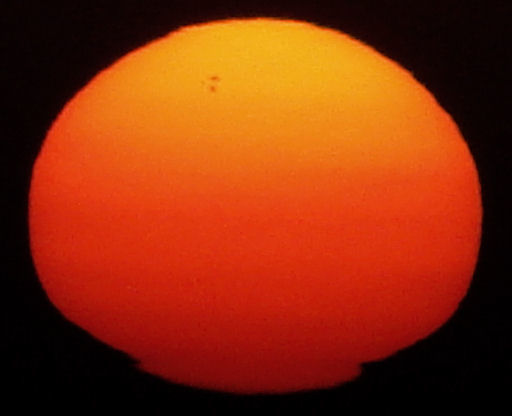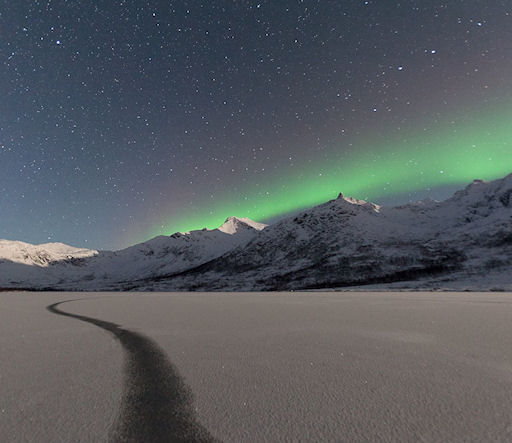SHADOWS ON JUPITER: On Saturday night, Oct. 30th, two of Jupiter's moons (Europa and Ganymede) will simultaneously cast their shadows on the giant planet's cloudtops. The closely-spaced shadows will be visible in mid-sized backyard telescopes and live on the web. The time to look is between 9:16 p.m. and 11:59 p.m. Pacific Daylight Time. [sky map]
ASTEROID FLYBY: Asteroid 2003 UV11 flew past past Earth last night only 1.2 million miles away. Many amateur astronomers were able to photograph the 600 meter-wide space rock racing like Speedy Gonzales among the stars of Andromeda and Pegasus. Browse the images: #1, #2, #3, #4, #5, #6, #7, #8, #9, #10, #11
SUNSPOT SUNRISE: Sunspot 1117 is now so large, it can be seen without the aid of a solar telescope. Mohamad Soltanolkottabi "spotted it" this morning when the sun was rising over Esfahan, Iran:

"I took this photo while climbing up Sofe mountain," says Soltanolkottabi. "It was a good way to start the day."
Although the sunspot is big--its primary core is four times wider than Earth--it is also quiet. The sunspot's magnetic field has relaxed into an uncomplicated state that seems to pose little threat for solar flares. There is, however, a high probability of photo-ops. Stay tuned.
more images: from Monika Landy-Gyebnar of Veszprem, Hungary; from Cai-Uso Wohler of Bispingen, Germany; from Gianfranco Meregalli of Milano, Italy; from Pavol Rapavy of Observatory Rimavska Sobota, Slovakia; from Enrico Colzani and Andrea Bonacina of Sormano Astronomical Observatory, Italy; from Britta Suhre of Rosenheim, Bavaria, Germany; from Francois Rouviere of Mougins, France; from Matt Wastell of Brisbane, Australia; from Rogerio Marcon of Campinas SP Brasil; from John Chumack of Dayton, Ohio;
A QUIET NIGHT IN NORWAY: Last night's forecast called for little geomagnetic activity, but in northern Norway it only takes a little to produce a beautiful display. Helge Mortensen sends this Oct. 29th snapshot from the outskirts of Tromsø:

"The activity was very slow tonight, so the forecast was quite accurate," says Mortensen. "Nevertheless, a 15 second exposure with my Canon EOS 5D Mark II revealed the Northern Lights."
A more vivid display could appear on Nov. 1st when a solar wind stream is expected to brush past Earth's magnetic field. NOAA forecasters estimate a 30% chance of geomagnetic activity. High latitude sky watchers should remain alert for auroras.
UPDATED: October 2010 Aurora Gallery
[previous Octobers: 2009, 2008, 2007, 2006, 2004, 2003, 2002, 2001]
Potentially Hazardous Asteroids (
PHAs) are space rocks larger than approximately 100m that can come closer to Earth than 0.05 AU. None of the known PHAs is on a collision course with our planet, although astronomers are finding
new ones all the time.
On October 30, 2010 there were 1157 potentially hazardous asteroids.
Notes: LD means "Lunar Distance." 1 LD = 384,401 km, the distance between Earth and the Moon. 1 LD also equals 0.00256 AU. MAG is the visual magnitude of the asteroid on the date of closest approach. | | The official U.S. government space weather bureau |
| | The first place to look for information about sundogs, pillars, rainbows and related phenomena. |
| | Researchers call it a "Hubble for the sun." SDO is the most advanced solar observatory ever. |
| | 3D views of the sun from NASA's Solar and Terrestrial Relations Observatory |
| | Realtime and archival images of the Sun from SOHO. |
| | from the NOAA Space Environment Center |
| | the underlying science of space weather |

